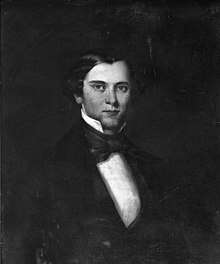John B. Galbraith
John B. Galbraith (1828 – 1869), also known as J. B. Galbraith, was an American politician from Florida. Galbraith served as the Florida Attorney General during the American Civil War.[1]
John B. Galbraith | |
|---|---|
 | |
| 6th Florida Attorney General | |
| In office March 2, 1861 – 1868 | |
| Governor | John Milton Abraham K. Allison William Marvin David S. Walker |
| Preceded by | Mariano D. Papy |
| Succeeded by | James Westcott III |
| 9th Speaker of the Florida House of Representatives | |
| In office November 28, 1858 – February 14, 1861 | |
| Preceded by | Hamlin Valentine Snell |
| Succeeded by | Samuel B. Love |
| Personal details | |
| Born | 1828 United States |
| Died | 1869 (aged 40–41) Florida, U.S. |
| Political party | Democratic |
Political career
At some point before December 31, 1852, Galbraith served as the Secretary of the Florida Senate.[2] After being elected to the Florida House of Representatives representing Leon County at an undetermined time, Galbraith, a Democrat, was selected to be the ninth Speaker of the Florida House of Representatives on November 28, 1858. In this position, he would oversee Florida's secession from the United States.[3] Galbraith would step down from this position on February 14, 1861 after being appointed the sixth Florida Attorney General by Governor John Milton.
During his tenure as wartime Attorney General, Florida's worsening economy and dissatisfaction with Milton led to the creation of an executive council tasked with begin a system of checks and balances to counter Milton. Though his predecessor, Mariano D. Papy, was appointed to the council, Galbraith was not, weakening his power.[4] Despite this, Galbraith still had a crucial role in boosting Florida's wartime economy. Galbraith instructed the trustees of Florida's Internal Improvement Fund to cancel construction of the St. Johns-Indian River Canal, as funds needed to be diverted to help the war effort.[5][6] Additionally, Galbraith oversaw the reformation and consolidation of the Florida state militia, which he saw as flawed and imperfect.[7]
Galbraith continued to serve as Florida's Attorney General through the end of the war and for a part of Reconstruction. During Reconstruction, he oversaw the imposition of Florida's Black Codes. Galbraith resigned as Attorney General in 1868, a year before the end of his second term.[8]
Death
Galbraith died in Florida in 1869, not long after resigning his position.[8]
References
- "Florida Attorney General - Florida Attorneys General (1845 - )". myfloridalegal.com. Retrieved March 27, 2019.
- Representatives, Florida Legislature House of (1852). A Journal of the Proceedings of the House of Representatives of the ... General Assembly of the State of Florida, at Its ... Session.
- "LEGISLATIVE LEADERSHIP 1822 to Present" (PDF). Florida Senate. Retrieved March 27, 2019.
- Florida, State Library and Archives of. "Civil War". Florida Memory. Retrieved March 27, 2019.
- Wynne, Nick; Knetsch, Joe (August 31, 2015). On This Day in Florida Civil War History. Arcadia Publishing. ISBN 9781625856111.
- "Lakeland Ledger - Google News Archive Search". news.google.com. Retrieved March 27, 2019.
- "Florida. General Assembly. House of Representatives. A Journal of the Proceedings of the House of Representatives of the General Assembly of the State of Florida, at its Eleventh Session ..." docsouth.unc.edu. Retrieved March 27, 2019.
- Florida, State Library and Archives of. "Florida Governors". Florida Memory. Retrieved March 27, 2019.